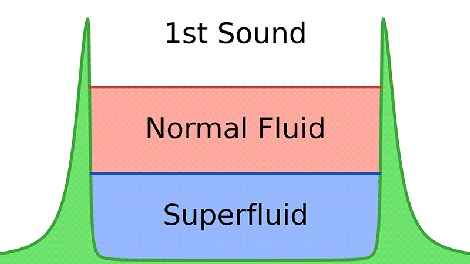Physicists at MIT have spotted the second sound of a superfluid. Besides being pleasantly alliterative, the phenomenon may explain how heat moves through certain rare materials on Earth and deep in space.
A superfluid is a state of matter that flows without friction. This happens at temperatures near absolute zero, where the motion of atoms is greatly reduced. In some materials—including superfluids like the quantum gas of lithium atoms, used by the recent team—heat propagates like a wave instead of diffusing.
“It’s as if you had a tank of water and made one half nearly boiling,” said Richard Fletcher, a physicist at MIT and co-author of the study, in an MIT release. “If you then watched, the water itself might look totally calm, but suddenly the other side is hot, and then the other side is hot, and the heat goes back and forth, while the water looks totally still.”

The Hungarian-American physicist László Tisza—also of MIT—suggested in 1938 that superfluids actually contain normal fluids as well. In this mixture, density waves are the “first sound” and the wave-like motion of temperature is the “second sound.”
At such frigid temperatures, no infrared radiation is emitted to signal the heat’s movement. The researchers instead witnessed the heat’s movement at radio frequencies; the higher the atoms’ temperatures, the higher the frequency at which they would resonate.

“For the first time, we can take pictures of this substance as we cool it through the critical temperature of superfluidity, and directly see how it transitions from being a normal fluid, where heat equilibrates boringly, to a superfluid where heat sloshes back and forth,” said Martin Zwierlein, a physicist at MIT who led the new research.
Their superfluid—a collection of supercooled lithium fermions—was one million times thinner than air, Zwierlein added. By following the motion of heat across the fermions based on their resonance, the team observed the wave-like motion—the second sound—for the first time. The findings are published in the journal Science.
The team believes their scrutiny of heat flow in the lithium can be used to determine heat flow in high-temperature superconductors, or even in neutron stars, the roiling, ultra-dense relics of ordinary stars. Neutron star interiors are thought to consist of interacting quantum liquids, and some physicists have theorized they may be sources of axionic dark matter.
Whatever bizarre physics are yet to be unlocked at the stars’ cores, better understanding heat’s motion through low-resistance materials could improve engineers’ ability to build room-temperature superconductors, a vaunted goal of energy research.
